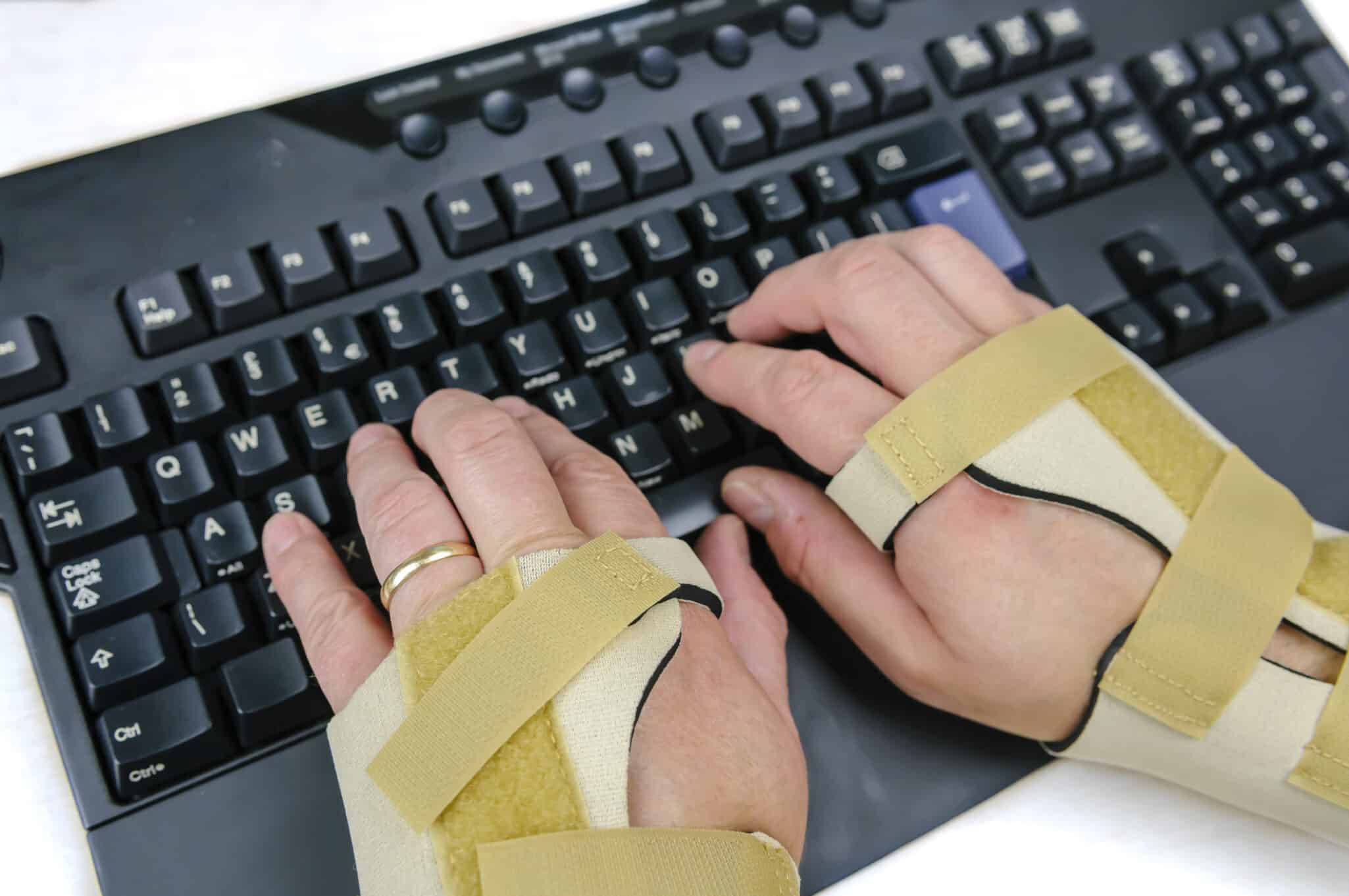The carpal tunnel is a narrow, fibrous passage in the wrist that protects the median nerve, which controls movement and sensation in the hand and thumb, index, and middle fingers. This area can be easily irritated by a change in tissue position that causes the carpal tunnel to squeeze and compress the nerve. When irritated, the median nerve can cause tingling and numbness in the fingers, a condition known as carpal tunnel syndrome.

Nerves are most often irritated when pressure is applied from surrounding structures. This pressure is known as impingement or nerve entrapment and can cause numbness, tingling, pain, and weakness throughout the affected area.
Carpal Tunnel Syndrome Symptoms
Carpal tunnel syndrome is a common condition that most often affects people whose jobs require repetitive use of their hands, and is also more common in women. This condition spreads gradually and usually begins as an ache in the wrist that may extend down to the forearm or up to the hand. As CPS develops, you may also experience tingling or numbness in the fingers or pain radiating through the entire arm. Some people may also experience weakness in the hand and arm and may have difficulty grasping small objects. These symptoms are usually most severe when first waking up or when using your hands.
Although most people associate carpal tunnel syndrome with pain and tingling in the fingers, it is important to note that this condition does not affect the pinky finger. If you are experiencing symptoms in this finger, you may be suffering from another condition.
How is Carpal Tunnel Syndrome diagnosed?
It’s likely your primary care physician will have an idea you have carpal tunnel syndrome, and he or she will probably send you to our experienced team at Texas Neurosurgery for confirmation and treatment. Here are some of the possible tools we will use to diagnose your condition:
- Symptom history — We’ll review the pattern of your symptoms. Because the median nerve doesn’t serve the outer ring finger and the pinky finger, the tingling or numbing of those fingers can point to something other than carpal tunnel syndrome. You’ll notice tingling and pain when doing things such as grasping the newspaper, holding your phone, or typing on a computer.
- Physical exam — We will test the feeling in your fingers and the strength of the muscles in your hand. We’ll bend your wrist, tap on the nerve, or press on the nerve, as this will usually trigger symptoms.
- X-rays — X-rays can be used to rule out other possible causes, such as a fracture or arthritis.
- Electromyogram — This test measures electrical discharges produced in the muscles. This can eliminate other conditions and identify if you have muscle damage.
- Nerve conduction study — This test passes a small shock through the median nerve. It tells if the electrical impulses slow as they pass through the carpal tunnel.
What are the surgical treatment options for Carpal Tunnel Syndrome?
At Texas Neurosurgery, we perform carpal tunnel release surgeries as outpatient procedures. We will discuss with you the two options for these procedures, open surgery or endoscopic surgery. There are pluses and minuses with both methods, although the success of the final outcome shows no difference between the two methods. The goal is to relieve pressure on the median nerve by cutting the transverse carpal ligament that forms the roof of the carpal tunnel. When this ligament is cut, this increases the size of the tunnel and decreases pressure on the median nerve.
- Open carpal tunnel release — In this method, we make a two-inch incision in the middle of the palm of your hand. This provides the best view of the problematic area and it involves less risk of accidentally damaging the median nerve. We then cut the transverse carpal ligament, and the incision is closed with stitches. Scar tissue will eventually fill the gap where the ligament was cut.
- Endoscopic carpal tunnel release — In the endoscopic method, two small incisions are made in the wrist and in the palm of the hand. An endoscope is inserted into the wrist incision to provide visuals inside the hand. A special scalpel is then inserted through the palm incision and is used to cut the transverse carpal ligament. The small incisions are closed with stitches. As you would assume, recovery is easier with this method compared with the open method.
Carpal Tunnel Syndrome Treatment
Carpal tunnel syndrome can usually be treated through conservative methods that include:
-
- Resting the hands
- Applying cold packs
- Anti-inflammatory medication
- Corticosteroid injections
- Splints
- Physical therapy
These treatments work to relieve symptoms and are usually effective in doing so. CPS caused by other conditions can often be relieved by treating the underlying cause.

Can Carpal Tunnel Syndrome go away on its own? What if I don’t treat it?
At Texas Neurosurgery we deal with complications caused by compressed nerves every day. Carpal tunnel syndrome is one of them. This is not something to “tough out.” When a nerve is compressed, such as the median nerve is with carpal tunnel syndrome, at some point permanent nerve damage will occur. This means permanent loss of function in the areas served by that nerve. In this case, that means your hand and your most important fingers.
If you are in the early stages of carpal tunnel, you may be able to change your office layout or alter your behaviors to take the stresses off of your wrist. But once the condition has developed to a certain degree it’s unlikely it will go away on its own. That’s where our Texas Neurosurgery surgeons will create space for the nerve and relieve your pain and growing weakness in your fingers.
Are Corticosteroid Injections for Carpal Tunnel Syndrome painful?
The injection of corticosteroids into the inflamed space of the carpal tunnel is typically a temporary method for relieving the patient’s pain. The skin over your wrist is cleaned with antiseptic liquid. A small needle is passed through your skin directly into the carpal tunnel using ultrasound images to guide the placement of the needle. A small amount of corticosteroid combined with local anesthetic is then injected, and the needle is removed. This procedure is quick and easy.

After your injection, corticosteroids often make the pain from your carpal tunnel syndrome worse. Symptoms caused by nerve compression generally take longer to respond to corticosteroid injections than symptoms caused by muscles or tendons. With these injections, your pain and discomfort may continue and occasionally get worse for a couple of days before the corticosteroid calms the inflammation and reduces your pain.
How long do Carpal Tunnel Treatment results last?
If you are able to change the conditions that caused early carpal tunnel syndrome, you may be able to keep the condition from worsening for the duration. Corticosteroid injections can provide relief for anywhere from a few weeks to a few months, depending on the patient.
Carpal tunnel release surgery is a permanent solution for the majority of patients. But the condition can recur. There is a wide variation in research on this, but recurrence rates have been shown to be from 3 to 25 percent.
Are there ways I can prevent or lessen my chances of developing Carpal Tunnel Syndrome?
For some people, they simply have less room through their carpal tunnel, and compression is almost pre-ordained. Nothing has been proven as a steadfast way to prevent the development of carpal tunnel syndrome. But there are methods you can use to minimize certain stresses placed on your wrists and hands, and this may limit the possible inflammation of the ligaments that then compress the median nerve.
- Take breaks — Take breaks to bend your hands and wrists. Gently stretch them. Alternate tasks, if possible.
- Lighten up — Hit the keys on the keyboard softly. Use a larger pen for prolonged handwriting.
- Pay attention to your form — Keep your keyboard at elbow height or slightly lower. Avoiding bending your wrist to full extension.
- Change your mouse — Get an ergonomic mouse that doesn’t strain your wrist.
- Keep your hands warm — Working in a cold environment makes it more likely you’ll develop hand pain and stiffness. If you need to, wear fingerless gloves that keep your hands and wrists warm.
Schedule Your Consultation Today
If you’re interested in learning more about carpal tunnel syndrome please contact us for a consultation at 214-823-2052 or fill out our contact us form. We will discuss your needs and concerns, and determine your best course of action.

